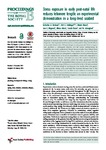Stress exposure in early post-natal life reduces telomere length: an experimental demonstration in a long-lived seabird
| dc.contributor.author | Herborn, Katherine | |
| dc.contributor.author | Heidinger, BJ | |
| dc.contributor.author | Boner, W | |
| dc.contributor.author | Noguera, JC | |
| dc.contributor.author | Adam, A | |
| dc.contributor.author | Daunt, F | |
| dc.contributor.author | Monaghan, P | |
| dc.date.accessioned | 2018-09-10T08:24:18Z | |
| dc.date.available | 2018-09-10T08:24:18Z | |
| dc.date.issued | 2014-05-07 | |
| dc.identifier.issn | 0962-8452 | |
| dc.identifier.issn | 1471-2954 | |
| dc.identifier.other | ARTN 20133151 | |
| dc.identifier.uri | http://hdl.handle.net/10026.1/12261 | |
| dc.description.abstract |
<jats:p>Exposure to stressors early in life is associated with faster ageing and reduced longevity. One important mechanism that could underlie these late life effects is increased telomere loss. Telomere length in early post-natal life is an important predictor of subsequent lifespan, but the factors underpinning its variability are poorly understood. Recent human studies have linked stress exposure to increased telomere loss. These studies have of necessity been non-experimental and are consequently subjected to several confounding factors; also, being based on leucocyte populations, where cell composition is variable and some telomere restoration can occur, the extent to which these effects extend beyond the immune system has been questioned. In this study, we experimentally manipulated stress exposure early in post-natal life in nestling European shags (<jats:italic>Phalacrocorax aristotelis</jats:italic>) in the wild and examined the effect on telomere length in erythrocytes. Our results show that greater stress exposure during early post-natal life increases telomere loss at this life-history stage, and that such an effect is not confined to immune cells. The delayed effects of increased telomere attrition in early life could therefore give rise to a ‘time bomb’ that reduces longevity in the absence of any obvious phenotypic consequences early in life.</jats:p> | |
| dc.format.extent | 20133151-20133151 | |
| dc.format.medium | Electronic-Print | |
| dc.language | en | |
| dc.language.iso | eng | |
| dc.publisher | The Royal Society | |
| dc.subject | ageing | |
| dc.subject | stress | |
| dc.subject | telomere | |
| dc.subject | senescence | |
| dc.subject | lifespan | |
| dc.subject | Phalacrocorax aristotelis | |
| dc.title | Stress exposure in early post-natal life reduces telomere length: an experimental demonstration in a long-lived seabird | |
| dc.type | journal-article | |
| dc.type | Journal Article | |
| dc.type | Research Support, Non-U.S. Gov't | |
| dc.type | Research Support, U.S. Gov't, Non-P.H.S. | |
| plymouth.author-url | https://www.webofscience.com/api/gateway?GWVersion=2&SrcApp=PARTNER_APP&SrcAuth=LinksAMR&KeyUT=WOS:000334410100013&DestLinkType=FullRecord&DestApp=ALL_WOS&UsrCustomerID=11bb513d99f797142bcfeffcc58ea008 | |
| plymouth.issue | 1782 | |
| plymouth.volume | 281 | |
| plymouth.publication-status | Published | |
| plymouth.journal | Proceedings of the Royal Society B: Biological Sciences | |
| dc.identifier.doi | 10.1098/rspb.2013.3151 | |
| plymouth.organisational-group | /Plymouth | |
| plymouth.organisational-group | /Plymouth/Faculty of Science and Engineering | |
| plymouth.organisational-group | /Plymouth/Faculty of Science and Engineering/School of Biological and Marine Sciences | |
| plymouth.organisational-group | /Plymouth/REF 2021 Researchers by UoA | |
| plymouth.organisational-group | /Plymouth/REF 2021 Researchers by UoA/UoA04 Psychology, Psychiatry and Neuroscience | |
| plymouth.organisational-group | /Plymouth/Users by role | |
| plymouth.organisational-group | /Plymouth/Users by role/Academics | |
| dc.publisher.place | England | |
| dc.identifier.eissn | 1471-2954 | |
| dc.rights.embargoperiod | Not known | |
| rioxxterms.versionofrecord | 10.1098/rspb.2013.3151 | |
| rioxxterms.licenseref.uri | http://www.rioxx.net/licenses/all-rights-reserved | |
| rioxxterms.type | Journal Article/Review |


